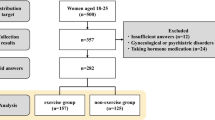Abstract
This study considers primary dysmenorrhea from a biopsychosocial perspective in examining the relationship between physical exercise and menstrual pain. Despite widespread claims of the benefits of exercise for perimenstrual symptoms, the evidence seems weak. Stronger evidence indicates that exercise helps relieve stress and elevates mood and that stress heightens menstrual discomfort. Student nurses (n=176) completed a questionnaire disguised as a general health survey that contained these measures. The hierarchial regression analysis demonstrated that, contrary to the expected, regular exercise increased with the severity of menstrual symptoms, after controlling for medications, disposition, perceived stress, and mood. The findings suggest that exercise presents a tradeoff; it relieves the stress that may intensify dysmenorrhea, yet it may aggravate these same symptoms.
Similar content being viewed by others
References
Artal, R. M., and Wiswell, R. A. (1986).Exercise in Pregnancy, Williams and Wilkins, Baltimore.
Aubuchon, P. G., and Calhoun, K. S. (1985). Menstrual cycle symptomatology: The role of social expectancy and experimental demand characteristics.Psychosom. Med. 47(1): 35–45.
Bains, G. K., and Slade, P. (1988). Attributional patterns, moods, and the menstrual cycle.Psychosom. Med. 50: 469–476.
Bradburn, N. M. (1969).The Structure of Psychological Well-Being, Aldine, Chicago.
Brown, J. D., and Siegel, J. M. (1988). Exercise as a buffer of life stress: A prospective study of adolescent health.Health Psychol. 7(4): 341–353.
Casperson, C. J., Christenson, G. M., and Pollard, R. A. (1986). Status of the 1990 physical fitness and exercise objectives-Evidence from NHIS 1985.Pub. Health Rep. 101(6): 587–592.
Chesney, M. A., and Tasto, D. L. (1975). The development of the menstrual symptom questionnaire.Behav. Res. Ther. 13: 237–244.
Clarvitt, S. R. (1988). Stress and menstrual dysfunction.Psychosomatics 29(4): 404–409.
Cohen, S., Kamarck, T., and Mermelstein, R. (1983). A global measure of perceived stress.J. Health Soc. Behav. 24: 395–396.
Colt, E. W., Wardlaw, S. L., and Frantz, A. G. (1981). The effect of running on plasma beta endorphin.Life Sci. 28: 1637–1640.
Dawood, M. Y., McGuire, J. L., and Demers, L. M. (1985).Premenstrual Syndrome and Dysmenorrhea, Urban and Schwarzenberg, Baltimore.
Denney, D. R., and Gerrard, M. (1981). Behavioral treatments of primary dysmenorrhea: A review.Behav. Res. Ther. 19: 303–312.
Diener, E. (1984). Subjective well-being.Psychol. Bull. 95(3): 542–575.
Fields, H. L. (1987).Pain, McGraw-Hill, New York.
Folkins, C. H., and Sime, W. E. (1981). Physical fitness training and mental health.Am. Psychol. 36(4): 373–389.
Golub, L., Menduke, H., and Lang, W. R. (1954). Exercise and dysmenorrhea in young teenagers.Am. J. Obstet. Gynecol. 32: 508–511.
Greenblatt, R. B.,et al. (1987). Premenstrual syndrome: What it is and what it is not.Stress Med. 3: 193–198.
Haack, M. R. (1988). Stress and impairment among nursing students.Res. Nurs. Health. 11: 125–134.
Hayes, D., and Ross, C. E. (1986). Body and mind: The effect of exercise, overweight, and physical health on psychological well-being.J. Health Soc. Behav. 27: 387–400.
Hughes, J. R. (1984). Psychological effects of habitual aerobic exercise: A critical review.Prev. Med. 13: 66–78.
Israel, R. G., Sutton, M., and O'Brien, K. F. (1985). Effects of aerobic training on primary dysmenorrhea symptomatology in college females.J. Am. Coll. Health 33: 241–244.
Jordon, J., and Meckler, J. R. (1982). The relationship between life change events, social supports, and dysmenorrhea.Res. Nurs. Health 5: 73–79.
Lazarus, R. S. (1977). Psychological stress and coping in adaptation and illness. In Lipowski, A. J., Lipsi, D. R., and Whybrow, P. C. (eds.),Psychosomatic Medicine: Current Trends, Oxford University Press, New York.
Logue, C. M., and Moos, R. H. (1986). Perimenstrual symptoms: Prevalence and risk factors.Psychosom. Med. 48(6): 388–414.
Macintyre, S. (1988). A review of social patterning and significance of measures of height, weight, blood pressure and respiratory function.Soc. Sci. Med. 27(4): 327–337.
Martinsen, E. W. (1987). The role of aerobic exercise in the treatment of depression.Stress Med. 3: 93–100.
Morgan, W. P., and Goldston, E. (1987).Exercise and Mental Health, Hemisphere, New York.
Mosler, C. D. (1914). Dysmenorrhea.JAMA 62: 1297–1301.
Olasov, B., and Jackson, J. (1987). Effects of expectancies on women's reports of moods during the menstrual cycle.Psychosom. Med. 49(1): 65–78.
Osterweis, M., Kleinman, A., and Mechanic, D. (1987). Illness behavior and the experience of pain. InPain and Disability: Clinical, Behavioral, and Public Policy, National Academy Press, Washington, DC.
Pickles, V. R. (1967). Prostaglandins in the human endometrium.Int. J. Fertil. 12: 335–338.
Prior, J. C., and Vigna, Y. (1987). Conditioning exercise and premenstrual symptoms.J. Reprod. Med. 32(6): 423–428.
Prior, J. C.,et al. (1987). Conditioning exercise decreases premenstrual symptoms: A prospective, controlled 6-month trial.Fertil. Steril. 47: 402–408.
Reid, R. L., and Yen, S. S. (1983). The premenstrual syndrome.Clin. Obstet. Gynecol. 26: 710–712.
Scheier, M. F., and Carver, C. S. (1985). Optimism, coping, and health: Assessment and implications of generalized outcome expectancies.Health Psychol. 4(3): 219–247.
Slade, P. (1984). Premenstrual emotional changes in normal women: Fact or fiction?J. Psychosom. Res. 28: 1–7.
Smith, R. P. (1986). Drug therapy for dysmenorrhea.IMJ 169(1): 22–25.
Sommer, B. (1978). Stress and menstrual distress.J. Hum. Stress 4: 5–10, 41–47.
Speroff, L., Glass, R. H., and Kase, N. G. (1983).Clinical Gynelogic Endocrinology and Infertility, Williams and Wilkins, Baltimore.
Timonen, S., and Procope, B. J. (1971). Premenstrual syndrome and physical exercise.Acta Obstet. Gynecol. Scand. 50: 331–337.
van den Akker, L., and Steptoe, A. (1985). The pattern and prevalence of symptoms during the menstrual cycle.Br. J. Psychiat. 147: 164–169.
Vingherhoets, A. J., and Marcelissen, F. H. (1988). Stress research: Its present status and issue for future developments.Soc. Sci. Med. 26(3): 279–291.
Whittle, G. C., Slade, P., and Ronalds, C. M. (1987). Social support in women reporting dysmenorrhea.J. Psycosom. Med. 31(1): 79–84.
Woods, N. F. (1985). Relationship of socialization and stress to perimenstrual symptoms, disability, and menstrual attitudes.Nurs. Res. 34(3): 145–149.
Author information
Authors and Affiliations
Additional information
This work was funded by BRSG, Medical College of Georgia.
Rights and permissions
About this article
Cite this article
Metheny, W.P., Smith, R.P. The relationship among exercise, stress, and primary dysmenorrhea. J Behav Med 12, 569–586 (1989). https://doi.org/10.1007/BF00844826
Accepted:
Issue Date:
DOI: https://doi.org/10.1007/BF00844826




